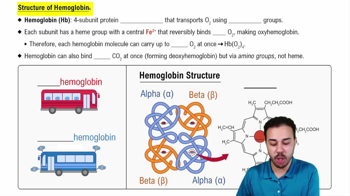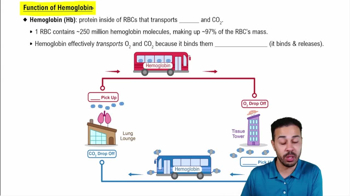Here are the essential concepts you must grasp in order to answer the question correctly.
Chemical Structure of Hemoglobin
Hemoglobin is a globular protein composed of four polypeptide chains, each containing a heme group that binds oxygen. The heme group consists of an iron ion at its center, which is crucial for oxygen binding. The quaternary structure of hemoglobin allows for cooperative binding, meaning that the binding of one oxygen molecule increases the affinity for additional oxygen molecules.
Recommended video:
Function of Hemoglobin
The primary function of hemoglobin is to transport oxygen from the lungs to the tissues and facilitate the return of carbon dioxide from the tissues back to the lungs. Hemoglobin's ability to bind oxygen is influenced by factors such as pH and carbon dioxide concentration, which are described by the Bohr effect. This ensures efficient oxygen delivery where it is most needed in the body.
Recommended video:
Color Changes During Oxygen Loading and Unloading
Hemoglobin exhibits distinct color changes based on its oxygenation state. When oxygen binds to hemoglobin, it transforms from a dark red color (deoxyhemoglobin) to a bright red color (oxyhemoglobin). This color change is due to alterations in the electronic structure of the heme group, which affects how light is absorbed and reflected, providing a visual indicator of oxygen saturation in the blood.
Recommended video:
Pressure Changes During Ventilation
 Verified step by step guidance
Verified step by step guidance


